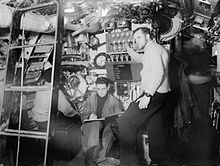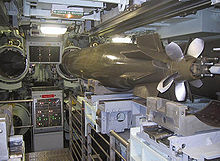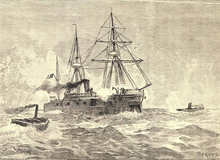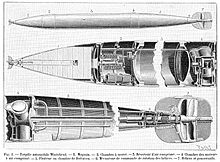Torpedo
![]()
This article explains the weapon torpedo; for other meanings, see Torpedo (disambiguation).
The modern torpedo is an underwater weapon with its own propulsion and an explosive charge. It detonates on contact or on approach to a target. The torpedo is mainly known as the main weapon of submarines, but can also be used by surface ships, aircraft and helicopters and fired from land. Apart from submarines, torpedoes have been used on torpedo boats and torpedo bombers, but destroyers and even cruisers and battleships have been equipped with torpedoes. There are also special sea mines that fire a torpedo. The firing is mostly done from so-called torpedo tubes. Aircraft, helicopters and small torpedo speedboats launch special torpedoes even without such launchers.
Torpedoes are classified according to their diameter in either inches (″) or centimeters (cm). Sizes from 17-22.5″ (approx. 43-57 cm) are common. In the German Navy, there were four sizes 35, 45, 50 and 60 cm until the end of the First World War. The Reichsmarine used only a diameter of 21 inches (53.3 cm) for naval vessels from 1927, and 45 cm for aerial torpedoes. Today's torpedoes usually have a diameter of 53.3 cm, torpedoes for anti-submarine warfare are 30-40 cm. The length and combat weight of torpedoes vary greatly. However, they are always several meters long and usually weigh more than a ton. Anti-submarine torpedoes, however, are considerably lighter at around 300 kg.
Torpedoes can form components of other weapon systems. For example, the NATO Mark 46 torpedo is the warhead of the ASROC anti-submarine missile and is also fired by the Mark 60 CAPTOR sea mine. The most widely used torpedo, which can only be fired by submarines, is currently the US Mark 48. On the new German Class 212 A submarines, the DM2A4 Seehecht is used.

A British sub-lieutenant at the torpedo launch control and a sailor with the book to log launches on an S-class submarine

Torpedo in a submarine before insertion into the torpedo tube

British, German and US torpedo from the Second World War (f.o.t.u.)
Word Origin
The Latin word "torpedo" means "stingray" and is also the scientific name of this genus of fish. The Latin term is a formation to "torpére", which can be translated as "to be stunned". This name has nothing to do with the shape of the weapon, but with the fact that electric rays can deliver "paralyzing blows".
In naval parlance, the term was first used by U.S. engineer Robert Fulton, who used it in 1800 in connection with his submarine Nautilus for a towed explosive charge that could attack ships from below.
The word torpedo entered common usage in the sense of destroy.
History
The term "torpedo" was initially used in a very undifferentiated way to refer to all kinds of explosive charges in the water, including sea mines. Thus, the famous quote "Damn the torpedoes! Full speed ahead! " (German: "To hell with the torpedoes! Full speed ahead!") by David Glasgow Farragut, which survives from the Battle of Mobile Bay, refers to mines and not torpedoes in the modern sense. Robert Fulton in his book Torpedo war, and submarine explosions mentions early trials in which on 15 October 1805 the ship Dorothea was blown in two by torpedo tests and sank within twenty seconds. In the broadest sense, the spar torpedo can be considered a precursor to what is now understood by torpedo. During the War of Secession, a way was sought to overcome ship armor by delivering a large explosive charge directly to the enemy ship by means of a rod (spar). The principle of operation was roughly the same as that of the petard. The first submarine to use a spar torpedo was the CSS Hunley, which used it to sink the Union forces' USS Housatonic on February 17, 1864. However, the Hunley sank herself after the attack for unexplained reasons.
The first screw-driven torpedoes were developed and built by Giovanni Luppis, an Austro-Hungarian naval officer. The propeller was operated by spring power, controlled from shore with cables. The presentation took place in 1860 in Fiume at the North Adriatic Sea in today's Croatia.
However, the so-called Whitehead torpedo, named after its builder, the English engineer Robert Whitehead, is considered the model for the principle and construction of modern torpedoes. Together with Luppis, Whitehead further developed the torpedo for the Austrian Navy and demonstrated it in Fiume in 1866. This torpedo carried a 9 kg explosive charge in the tip, had a range of 300 to 400 meters and reached a speed of 6 knots. The energy source for the propulsion was air compressed to 40 kp/cm², which was carried in a pressure vessel.
In the early designs, the stabilizing fins were extended into the bow area to compensate for the counter-torque of the propulsion screw. Because of this characteristic appearance, these torpedoes were also called fish torpedoes. Since more modern designs are basically driven by two counter-rotating screws whose torques cancel each other out, they make do with comparatively small control surfaces. Given the low speeds of early torpedoes and the need to bring them very close to their target, they were referred to as launching a torpedo, whereas today they are referred to as firing.
The first successful use of Whitehead torpedoes to sink a ship occurred in the Russo-Ottoman War on 26 January 1878 in Batum harbour. The Russian torpedo boats Chesma (a 35-cm Whitehead torpedo was attached with ropes under the keel) and Sinope (the torpedo was launched from a tube located on a raft attached to the side of the hull) under the command of Stepan Osipovich Makarov sank the Turkish customs steamer Intikbah from a distance of 70 meters.
The development of the self-propelled torpedo led to a new quality in tactical thinking. Fast torpedo boats and destroyers were developed at the end of the 19th century, which in turn strongly influenced the designs and tactics of the large warships.
The first torpedoes used were straight-launchers and maintained their course until they hit their target or ran out of fuel. A further development is wire steering, i.e. by pulling out an electrically conductive connection between the torpedo and the launching point for at least part of the torpedo path. Modern torpedoes, on the other hand, usually have a combination of their own acoustic sensor (sonar) and remote control, usually via a fiber-optic cable.
Torpedo, 2nd half of the 19th century. The fins extending over almost the entire hull can be seen well.

Attack with a torpedo boat on the Chilean ship Cochrane during the Chilean Civil War of 1891.

Structure of the Whitehead torpedo. In the tip (left) is the explosive charge. The middle section is occupied by the pressure vessel. Behind it is the engine, which drives two counter-rotating screws. The latter are framed by fins.

Contemporary artistic depiction of a torpedo attempt in 1805, the brig Dorothea sank within twenty seconds (Robert Fulton)
Search within the encyclopedia